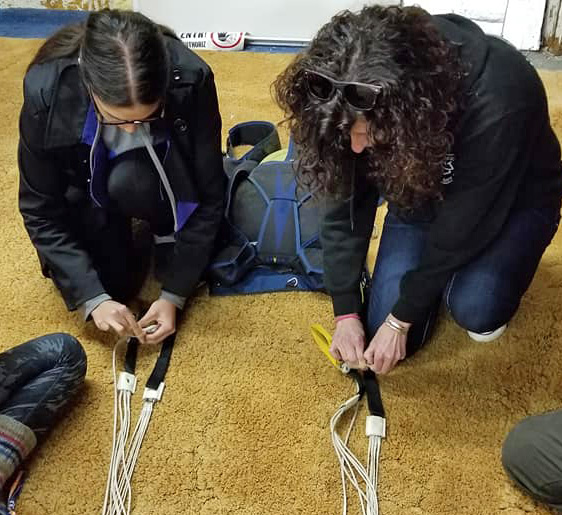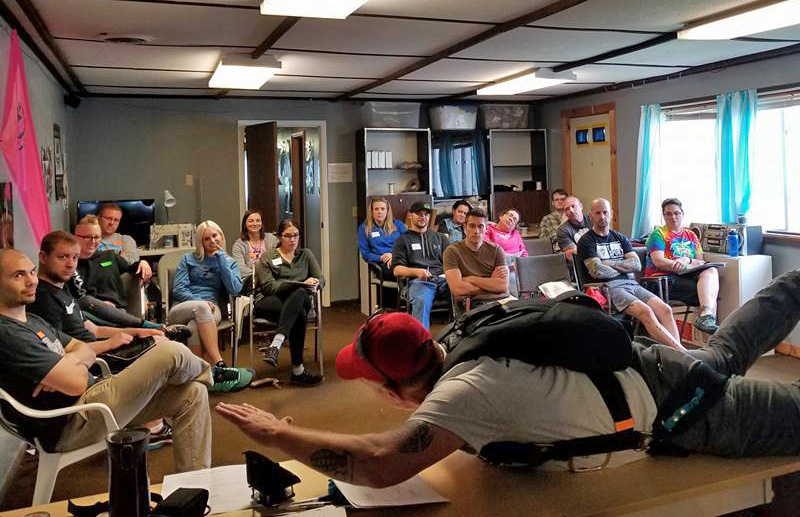Most folks who rock up for a first-time tandem skydive make one (or three!) triumphant leap of faith and ride that stoke forever. Others, however, find something up there that keeps them coming back — over and over and over and over.
Funding one’s life after “cutaway” from business-as-usual life on the ground seems like a significant challenge — especially when one doesn’t ever want to leave the dropzone, ever again — but there’s good news. As it turns out, it’s totally possible to make a career out of skydiving and become a professional skydiver without ever joining the military. And you don’t even have to spend all your time in freefall (if you don’t want to, that is).
Pack Parachutes
If finding professional footing in the skydiving industry were a board game, packing parachutes would be the very first square. Pretty much everyone starts there — because it’s by far the fastest means to work in the skydiving industry and make a buck. It looks more intimidating than it is (and it’s not easy on the body), but with solid training and practice, you could be folding magical laundry faster than you might think.

Take Pretty Pictures
Wanna fly? Your first gig is probably going to be in video. Skydiving videographers earn their way up the ranks by building hotshot freefall skills, capturing footage of first-timers enjoying skydiving for the very first time. Some of these participate in the filming aspect of our sport’s international competition circuit — or even go on to shoot aerial footage for Hollywood films. The minimum requirement to even begin training with a video camera is 200 jumps, so this one isn’t for the fly-by-night or the faint-of-heart.
Teach Newbies
Want even more freefall? Teach. The USPA offers a layer cake of different instructor ratings, each with a different set of minimum requirements (which are usually based on the number of jumps). The most popular (and, because we know you’re interested in this aspect, lucrative) instructor rating is that of the Tandem Instructor (TI). Loads of professional skydivers have built their careers around bringing new jumpers up for their first taste of sky. Because TIs are in high demand, there’s an adventure aspect here, too: You can stay as local as you like, but the job can easily take a person around the world and back. Interested? Get workin’. You’ll need to rack up a minimum of 500 jumps before you can apply for a training program.

Manage the Skydiving Equipment
Anyone who wants to skydive more than once needs a working parachute, and it’s the industry’s riggers that — y’know — have our backs. Literally. Without riggers, there wouldn’t be skydiving! Riggers aren’t just parachute packers; they’re the maintenance crew that keeps our parachutes in fine form. Riggers hold special certifications that allow them to inspect and repack our reserve parachutes (which the FAA mandates be taken out, checked and repacked every 180 days), as well as perform repairs.
Fill the Airplanes and Run the Show
If you’d rather work on the ground and skydive for fun, try on a job at Manifest for size. Every skydiving center in the country has one, as it’s the beating heart of the place where every departing flight is saddled up with the just-right combination of skydiving students, instructors, videographers and licensed skydivers. This is a detailed, complicated job, as it acts as the dropzone’s “nerve center” and sets the rhythm and pace for the operation. Ask any skydiver: A great manifester is rock-solid magic. Once you know the beat like the back of your hand, you can think about moving up to run the show — the DZM, or Dropzone Manager, acts as the general manager of the operation responsible for the coordination between the many different departments that all must work together for a successful outcome at the end of the day which is getting everyone up and down without injury.
Fly the Bus
Without a plane, skydiving is hecka boring. Why not fly it? There’s a shortcut to fixed-wing greatness inherent in the deal because serving as a pilot in the skydiving industry lets low-airtime pilots build up those precious hours, racking a prodigious number of takeoffs and landings. From the dropzone, it’s not a fantastically long path to the command deck of a commercial flight.
Traditional? Nope. Exciting? Definitely. Becoming a professional skydiver (or a professional in the skydiving industry) can take you higher than you might think. If you want to know more, come on down to the dropzone to observe and interact doing it right this second (in other words: us!). We’d love to answer your questions.





